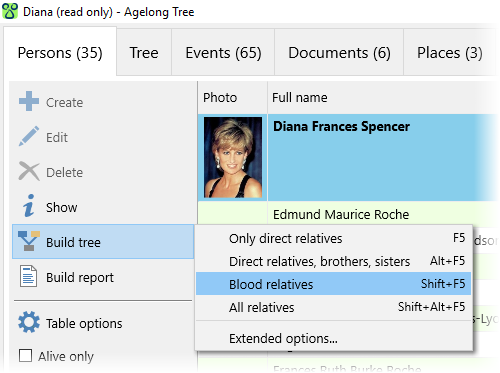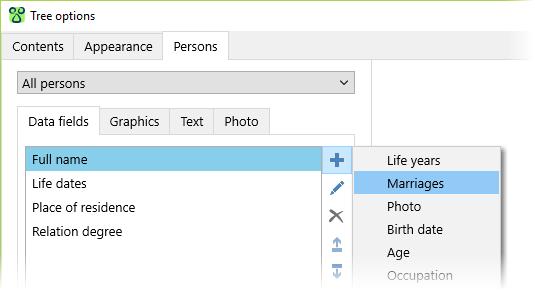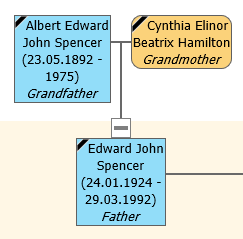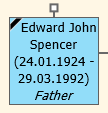Agelong Tree 5 Help
User Tools
General info
Data manipulation
Family tree
Reports
Files manipulations
Licensing
Extra
Table of Contents
Building a family tree
Agelong Tree builds family trees (or genealogical trees) based on information about persons and about the events which unite people into families. A genealogical tree can be constructed for any person selected in the table, this person is called the root of the tree:

Choose the type of the tree you need (direct relatives, blood relatives, etc) or go for Extended options to make your own family tree type.
In the tree options you can configure the contents of the tree (= the set of people displayed in the family tree), the tree view, the content and the appearance of persons in the tree (they are called tree nodes). The nodes of men are displayed in rectangles, the nodes of women are rectangles with rounded corners:

Working with the tree
You can move (scroll) the tree using the scrollbar, scroll wheel or holding the left mouse button and moving the mouse. When you click on the tree node, this node becomes active and is highlighted with a blue border, and you can also use the cursor arrows to move from one person to another. Double-clicking on the tree node opens the person's information window or person's edit window, depending on program options.
The actions in the upper half of the context action bar to the left of the tree (Create, Edit, etc.) apply to the active node of the tree. The same actions are available in the context menu of the tree node, the menu is called by the right mouse click on the tree node.
The actions in the lower half of the context action bar apply to the tree as a whole, the same actions are available in the context menu of the tree, which is called by the right mouse click between the nodes of the tree:
Tree options– tree options dialogue box is displayedRebuild– the tree is rebuilt, for the same person and with the same settingsZoom– selects the scale of the tree view. The tree is also scaled with the mouse wheel while holding down the Ctrl keyFull screen– switch to full-screen view of the tree. Double-clicking the left mouse button between tree nodes also switches the tree to this modeSave– saving a tree in one of the available formats (PNG, SVG, HTML)Print- go to print preview, where you can print a tree and save the tree by pages in PDF format. For printing a tree also see how to print a tree
Order of brothers and sisters in the tree
Brothers and sisters are placed in the tree according to the order of events of their birth on the Event tab in the edit window of their parent. If the dates of birth are not specified or are specified approximately, then this order can be changed:

However, note that in some cases Agelong Tree will still place brothers and sisters in violation of this order, otherwise it is impossible to build a tree.
Marriages and divorces in the tree
You can display spouses of a person and the dates of marriages/divorces: add the field Marriages into the list of displayed fields (see Tree options window, tab Persons, tab Data fields):

Hide or show a tree branch
Some branches of the tree can be hidden. To hide a branch click on the sign  which appears when you place the cursor on the tree node:
which appears when you place the cursor on the tree node:

The hidden branch of the tree is marked with a short line and a small square at the end:

To show the hidden branch again you have to click on the sign  which appears when you place the cursor on the tree node with the hidden branch.
which appears when you place the cursor on the tree node with the hidden branch.
